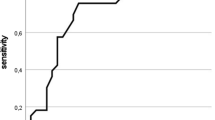Abstract
Hemoptysis is a common clinical emergency, bronchial arterial embolization is considered to be an effective treatment. The presence of coronary artery—bronchial artery fistula (CBF) may lead to recurrence of hemoptysis after treatment. It is necessary to investigate the imaging characteristics of a CBF and its correlation with the severity of pulmonary disease. With the development of multi-detector computed tomography, our study used the 320-slice CT bronchial artery angiography technology to observe and visualize blood vessels. The image and clinical data of 2015 hemoptysis patients with 320-slice CT bronchial artery angiography were retrospectively reviewed from January 2015 to December 2019. The axial and three-dimensional CT images were analyzed. The incidence, anatomical characteristics of CBF and pulmonary disease severity score were evaluated. A total of 12 CBF vessels were detected in 11 patients. We found that the incidence of CBF in this group was 0.55% (11/2015). Mean CBF diameter was 1.9 mm (1.2–2.5 mm). The course of CBF usually was relatively fixed. The proportions of CBF originated from the left circumflex artery, right coronary artery, and left anterior descending artery were 75%, 16.7% and 8.3%, respectively. Preliminarily analysis of the correlation between the trend of CBF and the pulmonary diseases severity score showed that CBF was more likely to communicate with a bronchial artery on the side with a higher severity score. CBF may occur in patients with chronic pulmonary disease and hemoptysis, and its origin, course and trend are characteristic. Detailed and comprehensive computed tomography angiography image analysis is helpful to improve the clinical treatment of hemoptysis with CBF.



Similar content being viewed by others
References
Bruzzi JF, Rémy-Jardin M, Delhaye D (2006) Multi-detector row CT of hemoptysis. Radiographics 26:3–22
Ramírez Mejía AR, Méndez Montero JV, Vásquez-Caicedo ML (2016) Radiological evaluation and endovascular treatment of hemoptysis. Curr Probl Diagn Radiol 45:215–224
Yoon W, Kim JK, Kim YH (2002) Bronchial and nonbronchial systemic artery embolization for life-threatening hemoptysis: a comprehensive review. Radiographics 22:1395–1409
Walker CM, Rosado-de-Christenson ML, Martínez-Jiménez S (2015) Bronchial arteries: anatomy, function, hypertrophy, and anomalies. Radiographics 35:32–49
Lee WH, Jung GS, Cho YD (2009) Anomalous bronchial artery originating from the right coronary artery in a patient with angina. Eur Radiol 19:1822–1825
Bas S, Yiginer O, Atalay M (2010) Coronary-to-bronchial artery fistula with conventional and multi-detector computed tomography angiographic images. Hellenic J Cardiol 51:164–165
Chang YC, Yu CJ, Chang SC (2005) Pulmonary sequelae in convalescent patients after severe acute respiratory syndrome: evaluation with thin-section CT. Radiology 236:1067–1075
Lim JJ, Jung JI, Lee BY (2014) Prevalence and types of coronary artery fistulas detected with coronary CT angiography. AJR 203:W237–W243
Lee ST, Kim SY, Hur G (2008) Coronary-to-bronchial artery fistula: demonstration by 64-multidetector computed tomography with retrospective electrocardiogram-gated reconstructions. J Comput Assist Tomogr 32:444–447
Matsunaga N, Hayashi K, Sakamoto I (1993) Coronary-to-pulmonary artery shunts via the bronchial artery: analysis of cineangiographic studies. Radiology 186:877–882
Cho J, Shin T, Jun K (2010) Transcatheter embolization of bronchial artery arising from left circumflex coronary artery in a patient with massive hemoptysis. Cardiovasc Intervent Radiol 33:169–172
Yoon JY, Jeon EY, Lee IJ (2012) Coronary to bronchial artery fistula causing massive hemoptysis in patients with longstanding pulmonary tuberculosis. Korean J Radiol 13:102–106
Lee CM, Leung TK, Wang HJ (2007) Identification of a coronary-to-bronchial-artery communication with MDCT shows the diagnostic potential of this new technology: case report and review. J Thorac Imaging 22:274–276
Lee WS, Lee SA, Chee HK (2012) Coronary-bronchial artery fistula manifested by hemoptysis and myocardial ischemia in a patient with bronchiectasis. Korean J Thorac Cardiovasc Surg 45:49–52
Said SA, Oortman RM, Hofstra JH (2014) Coronary artery-bronchial artery fistulas: report of two Dutch cases with a review of the literature. Neth Heart J 22:139–147
Pestana Knight EM, Novelli PM, Joshi SM (2011) Cerebral and systemic infarcts after bronchial artery embolization. Pediatr Neurol 45:324–327
Massi F, Muretti M, Coradduzza E (2015) Myocardial infarction and rupture after bronchial artery embolization. Ann Thorac Surg 99:1051–1053
Labbé H, Bordeleau S, Drouin C (2017) Myocardial infarction as a complication of bronchial artery embolization. Cardiovasc Intervent Radiol 40:460–464
Kang WC, Moon C 2nd, Ahn TH (2008) Identifying the course of a coronary-bronchial artery fistula using contrast-enhanced multi-detector row computed tomography. Int J Cardiol 130:e125–e128
Acknowledgements
This study was supported by the Wenzhou Public Welfare Planning Project of Science and Technology Grant Y20180769.
Author information
Authors and Affiliations
Contributions
YC: Conceptualization, Methodology, Validation, Formal analysis, Investigation, Data curation, Writing—original draft, Visualization. LL: Methodology, Data curation, Writing—original draft, Writing—review & editing. QD, NL, ZW: Resources, Data curation, Writing—original draft, Visualization. JL: Methodology, Validation, Formal analysis, Supervision, Writing—review & editing. HS: Conceptualization, Resources, Data curation, Writing—review & editing, Visualization, Supervision, Project administration, Funding acquisition.
Corresponding authors
Ethics declarations
Conflict of interest
The authors declare that they have no conflict of interest.
Ethical statement
This study was approved by the First Affiliated Hospital of Wenzhou Medical University institutional ethics board. This was a retrospective study, and the requirement for written informed consent was waived.
Additional information
Publisher's Note
Springer Nature remains neutral with regard to jurisdictional claims in published maps and institutional affiliations.
Rights and permissions
About this article
Cite this article
Chen, Y., Lin, L., Deng, Q. et al. Coronary artery–bronchial artery fistula imaging characteristics and its correlation with pulmonary disease severity. Heart Vessels 37, 2101–2106 (2022). https://doi.org/10.1007/s00380-022-02106-y
Received:
Accepted:
Published:
Issue Date:
DOI: https://doi.org/10.1007/s00380-022-02106-y




